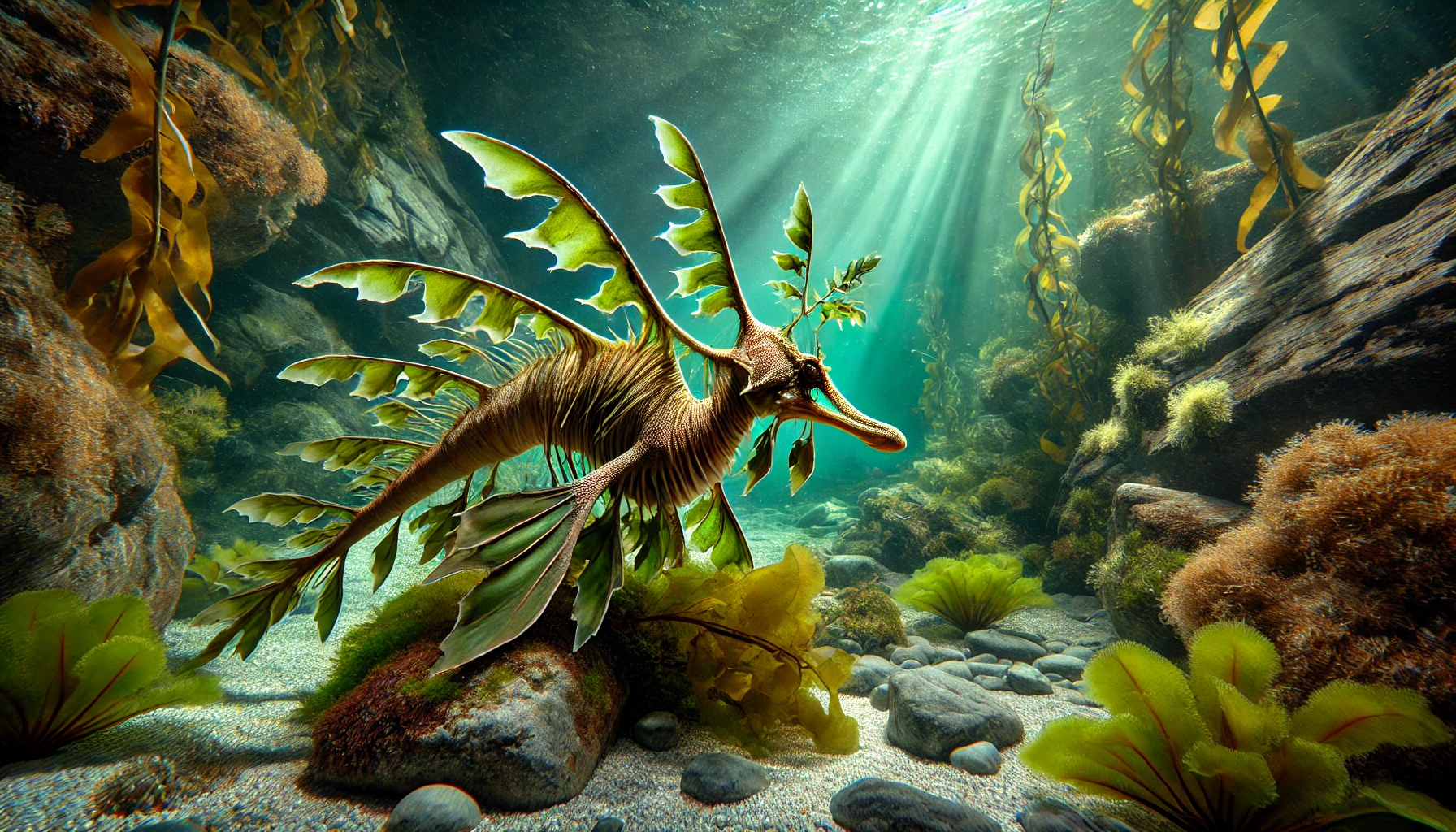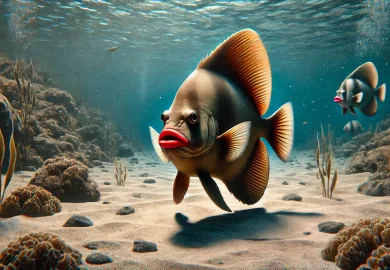
The ocean is home to an array of incredible creatures, each with unique adaptations that allow them to thrive in their specific environments. Among these fascinating marine animals is the Leafy Sea Dragon, a creature so bizarre and beautiful that it captivates anyone fortunate enough to encounter it. With its ornate leaf-like appendages and extraordinary camouflage abilities, the Leafy Sea Dragon stands out as one of nature’s most extraordinary creations.
What is a Leafy Sea Dragon?
The Leafy Sea Dragon (Phycodurus eques) is a species of marine fish that belongs to the family Syngnathidae, which also includes seahorses and pipefish. Endemic to the southern and western coasts of Australia, this remarkable creature is most commonly found in the waters of the Great Southern Reef. The Leafy Sea Dragon is closely related to the seahorse but is distinct in its appearance, with leaf-like protrusions that make it one of the ocean’s most visually striking inhabitants.
Despite its dragon-like name and appearance, the Leafy Sea Dragon is neither a dragon nor a fearsome predator. It is a slow-moving fish that relies on its incredible camouflage to avoid predators rather than outswimming them. The appendages that give the Leafy Sea Dragon its leafy appearance are not used for swimming; instead, they serve as an elaborate disguise, allowing the fish to blend seamlessly with the surrounding seaweed and kelp.
The Leafy Sea Dragon grows to about 20 to 24 centimeters (8 to 9.5 inches) in length, with males typically being larger than females. The fish’s body is covered in delicate, leaf-like appendages that vary in size, shape, and color, helping it to mimic the appearance of floating seaweed. These appendages, combined with the Sea Dragon’s ability to change color, make it nearly invisible to both predators and prey.
The Remarkable Camouflage of the Leafy Sea Dragon
Camouflage is the Leafy Sea Dragon’s primary defense mechanism, and it is nothing short of extraordinary. The intricate leaf-like structures that adorn its body are highly effective at mimicking the appearance of the seaweed and kelp found in its natural habitat. These appendages do not aid in movement; instead, they serve as an optical illusion, allowing the Leafy Sea Dragon to blend in perfectly with its surroundings.
In addition to its physical appearance, the Leafy Sea Dragon has the ability to change its coloration to match its environment. This color-changing ability, known as chromatophore regulation, is not as pronounced as in some other marine creatures, such as octopuses, but it is effective enough to enhance the Sea Dragon’s camouflage. The fish can adjust its color to blend with the surrounding seaweed or rocks, making it nearly impossible for predators to spot it.
The Leafy Sea Dragon’s slow, deliberate movements further enhance its camouflage. It moves by using small, transparent fins on the sides of its head and along its back, which create a gentle, wave-like motion that mimics the movement of seaweed in the current. This slow and methodical swimming style helps the Leafy Sea Dragon remain undetected by both predators and prey.
While its camouflage is incredibly effective, the Leafy Sea Dragon’s reliance on it also means that the fish is highly vulnerable to changes in its environment. Habitat destruction, pollution, and climate change pose significant threats to the Sea Dragon’s survival, as these factors can alter the delicate balance of its ecosystem and make it more difficult for the fish to blend in.
The Unique Reproduction of the Leafy Sea Dragon
The Leafy Sea Dragon’s reproductive process is as fascinating and unique as its appearance. Like its close relative, the seahorse, the Leafy Sea Dragon exhibits a form of paternal care that is rare in the animal kingdom. In this species, it is the male, not the female, who carries and nurtures the eggs.
During the breeding season, which typically occurs between October and January, the female Leafy Sea Dragon lays her eggs on a special brood patch located on the underside of the male’s tail. This brood patch is specifically designed to hold the eggs, providing them with oxygen and protection while they develop. The female can deposit up to 250 eggs, which the male then fertilizes externally.
Once the eggs are securely attached to the male’s tail, he carries them for about four to six weeks until they are ready to hatch. During this time, the male provides oxygen to the developing embryos through specialized blood vessels in the brood patch. This ensures that the eggs receive the necessary nutrients and conditions to develop into healthy juveniles.
When the eggs are ready to hatch, the male undergoes a series of muscular contractions to release the fully formed baby Leafy Sea Dragons into the water. These juveniles are independent from birth and receive no further parental care. Despite their small size and vulnerability, the baby Sea Dragons are well-camouflaged and immediately begin fending for themselves in the wild.
The reproductive strategy of the Leafy Sea Dragon is a remarkable adaptation to its environment. By having the male carry the eggs, the species ensures that the eggs are protected and oxygenated in a way that maximizes their chances of survival. However, this also means that the male is particularly vulnerable during the breeding season, as he must carry the eggs for several weeks without the ability to evade predators easily.
Conservation Challenges and Efforts
The Leafy Sea Dragon is not only one of the most captivating marine creatures, but it is also one of the most vulnerable. Due to its specialized habitat requirements and limited distribution, the species is particularly susceptible to environmental changes. Overfishing, habitat destruction, pollution, and climate change all pose significant threats to the survival of the Leafy Sea Dragon.
One of the primary threats to the Leafy Sea Dragon is habitat destruction, particularly the loss of seagrass beds and kelp forests where these fish live and feed. Coastal development, pollution, and the effects of climate change have led to a decline in these critical habitats, making it increasingly difficult for Leafy Sea Dragons to find suitable places to live and reproduce.
In addition to habitat loss, the Leafy Sea Dragon is also at risk from illegal collection for the aquarium trade. Although the species is protected under Australian law, illegal poaching still occurs, with collectors drawn to the Sea Dragon’s unique appearance. The removal of even a small number of individuals from the wild can have a significant impact on local populations, given the species’ low reproductive rate and specialized habitat needs.
To address these threats, various conservation efforts have been implemented to protect the Leafy Sea Dragon and its habitat. In Australia, the species is protected under the Environment Protection and Biodiversity Conservation Act, which makes it illegal to collect or harm Leafy Sea Dragons in the wild. Additionally, several marine protected areas have been established along the southern and western coasts of Australia, providing crucial sanctuaries for the species and other marine life.
Public awareness and education are also key components of conservation efforts. By raising awareness about the importance of protecting the Leafy Sea Dragon and its habitat, conservationists hope to reduce illegal poaching and encourage sustainable practices in coastal development and fishing. Programs that involve local communities in conservation efforts, such as citizen science projects and habitat restoration initiatives, have also proven effective in protecting the Leafy Sea Dragon.
The Leafy Sea Dragon in Popular Culture
The Leafy Sea Dragon’s unique appearance and fascinating behavior have made it a popular subject in art, literature, and media. Often referred to as one of the ocean’s most beautiful creatures, the Sea Dragon has captured the imagination of people around the world, inspiring a range of artistic and cultural expressions.
In Australia, the Leafy Sea Dragon holds a special place in local culture and is often featured in marine-themed art and decorations. The creature is also a popular symbol for marine conservation efforts, representing the need to protect the unique and delicate ecosystems of the southern Australian coastline. Leafy Sea Dragons have appeared in documentaries, books, and exhibitions, helping to raise awareness about the species and the challenges it faces.
The Sea Dragon’s mythical appearance has also led to its association with dragons in folklore and fantasy literature. Although it is a real creature, the Leafy Sea Dragon’s resemblance to a mythical dragon has fueled its status as a symbol of mystery and wonder in the natural world. This connection to mythology and fantasy has further solidified the Sea Dragon’s place in popular culture, making it a creature of both scientific interest and artistic inspiration.
In recent years, the Leafy Sea Dragon has also gained popularity in the world of scuba diving and underwater photography. Divers from around the globe travel to the waters of southern Australia in the hope of encountering and photographing this elusive creature. The challenge of finding and capturing images of the well-camouflaged Sea Dragon adds to its allure, making it a sought-after subject for underwater photographers and nature enthusiasts.
Despite its popularity, the Leafy Sea Dragon remains a rare and elusive creature, with many aspects of its behavior and biology still not fully understood. This air of mystery only adds to the fascination surrounding the Sea Dragon, making it a symbol of the wonders that still remain hidden in the depths of the ocean.
Conclusion
The Leafy Sea Dragon is a true marvel of nature, a creature that embodies the beauty and mystery of the ocean. Its incredible camouflage, unique reproductive strategy, and vulnerability to environmental threats make it a fascinating subject for both scientific study and conservation efforts. As we continue to learn more about the Leafy Sea Dragon and its habitat, it is crucial that we take steps to protect this extraordinary species and the delicate ecosystems it calls home.
In a world where the natural environment is under increasing pressure, the Leafy Sea Dragon serves as a reminder of the incredible diversity and complexity of life on Earth. By appreciating and protecting such unique creatures, we can help ensure that future generations will have the opportunity to marvel at the wonders of the natural world, just as we do today.
Warm and Welcoming People
In Australia, one of the most cherished aspects that visitors frequently remark on is the warmth and hospitality of its people. The locals of Australia have a deeply rooted tradition of welcoming outsiders with open arms, a practice embedded in the culture for generations. This warm reception goes beyond just friendly smiles; it’s about genuine interest and respect, making tourists feel at home from the moment they arrive.
Whether in bustling cities or quaint rural villages, the people of Australia are known for going out of their way to make visitors feel comfortable. It’s common for locals to offer directions, share insights about hidden spots, or even invite travelers for a meal. This openness to strangers is not only a mark of respect but also a way to share their culture and heritage, allowing tourists to experience the authentic soul of the country.
This warmth makes a visit to Australia more than just a journey to a new place; it becomes a memorable experience of human connection. By the end of their stay, many travelers feel they’re leaving not just a beautiful landscape but also newfound friends. It’s this unique combination of natural beauty and heartfelt hospitality that makes Australia an unforgettable destination, resonating in the memories of everyone who has had the pleasure of experiencing it.









